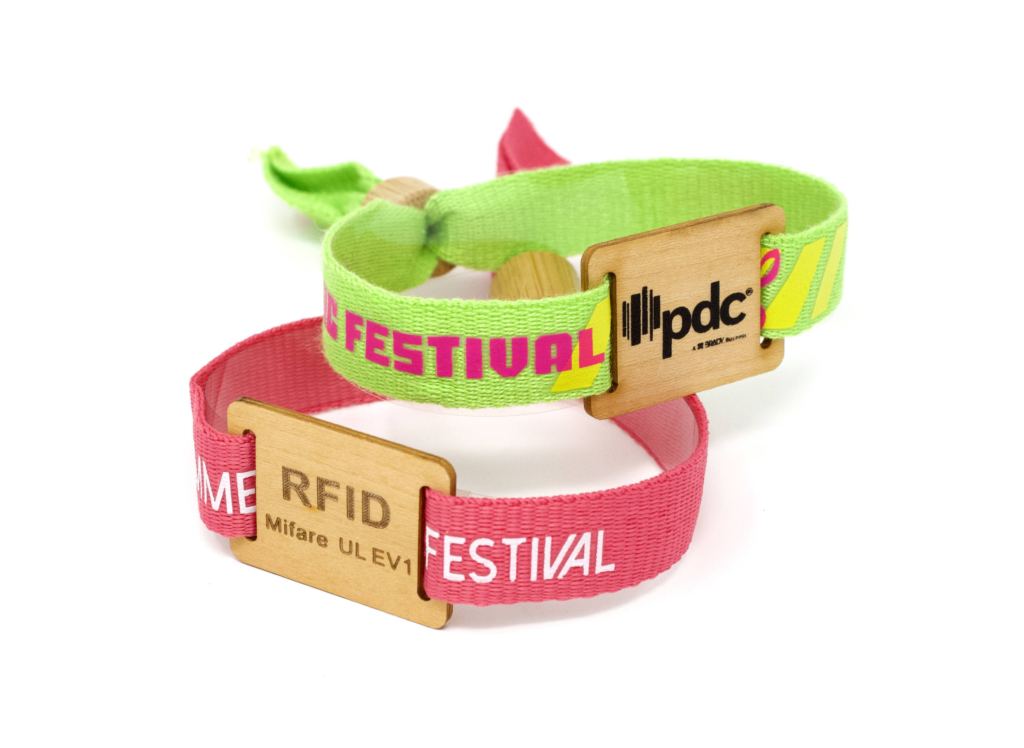
What types of RFID chips are used in woven wristband?
The RFID woven wristband is revolutionizing the way industries manage secure identification, payment, and access control. These versatile tools integrate RFID technology into durable, comfortable wristbands for various applications. The RFID chip is at the heart of its functionality, determining the wristband’s operation, range, compatibility, and specific use cases. Below, we’ll examine the different RFID chip types commonly found in woven wristbands, providing insight into their unique characteristics and real-world applications.
HF Chips: Suitable for a Variety of Applications
High-frequency (HF) chips are among woven wristbands’ most widely used RFID technologies. Operating at 13.56 MHz, HF chips offer a harmonious balance between affordability, functionality, and reliability. Their versatility makes them suitable for various applications, such as cashless payments at events, access control in workplaces, and hotel keycard systems. One notable advantage of HF chips is their compatibility with the ISO 14443 and ISO 15693 standards, which allow seamless interaction with NFC-enabled devices like smartphones and tablets.
RFID woven wristbands with HF chips typically offer a read range of up to 10 centimeters, depending on the environment and the reader’s configuration. This makes them ideal for situations where proximity scanning ensures security and convenience. For instance, music festivals often use HF-enabled wristbands to facilitate ticket validation and enable attendees to make cashless purchases. The result is a smoother, more enjoyable event experience for participants and improved operational efficiency for organizers. HF chips are also popular in healthcare settings, where authorized personnel use patient wristbands to store medical data for easy access.

LF Chips: Ideal for Professional Applications
Low-Frequency (LF) chips, operating at 125 kHz or 134.2 kHz, are another essential category used in RFID woven wristbands. These chips excel in environments where metal and liquid interference might compromise other RFID technologies. While their read range is limited to a few centimeters, LF chips provide unmatched reliability and stability, making them ideal for specialized applications such as animal tagging, industrial equipment tracking, and access control in challenging environments.
Consider a wristband solution designed for water parks. In such settings, the environment includes significant amounts of water, which can interfere with RFID performance. LF chips perform admirably in such conditions, enabling secure and reliable access control for visitors. Industries often use LF-enabled RFID woven wristbands in environments with heavy machinery and metal structures, ensuring efficient tracking and identification. The limited read range further enhances security, as these wristbands must be scanned at close range, reducing the risk of unauthorized access.
UHF Chips: For Large-Scale Applications
Ultra-High-Frequency (UHF) chips are a game-changer for industries requiring long-range tracking and data collection. Operating between 860 MHz and 960 MHz, these chips boast a read range of up to 10 meters, depending on the setup and environmental conditions. Manufacturers commonly use UHF chips in RFID woven wristbands for large-scale applications, such as crowd monitoring, asset tracking, and inventory management.
For example, consider a sports stadium that uses UHF-enabled wristbands for access management and real-time attendance tracking. These wristbands allow security personnel to monitor spectator movements seamlessly while providing valuable data insights into crowd density and behavior. Companies widely use UHF wristbands in logistics to efficiently track packages and shipments across extensive facilities. By choosing UHF-enabled RFID woven wristbands, businesses can achieve unparalleled operational efficiency and scalability, making them a preferred choice for high-demand applications.

NFC Chips: Enhancing Interactivity
Near-field communication (NFC) chips, a subset of HF chips, have gained immense popularity for their ability to facilitate interactive and engaging experiences. Event organizers, retailers, and hospitality providers widely use NFC-enabled RFID woven wristbands to allow users to share information, make payments, and unlock exclusive content with a simple tap.
Take, for instance, a global music festival that provides attendees with NFC wristbands. These wristbands enable participants to check in, access VIP areas, and interact with sponsors’ booths by tapping their wristbands on NFC-enabled devices. Beyond events, NFC-enabled wristbands have found applications in corporate environments, where they streamline access control and enable personalized employee experiences. Their ability to integrate with mobile apps further enhances convenience and functionality, making them a versatile choice for businesses seeking interactive RFID solutions.
Dual-Frequency RFID Chips: Expanding Functionality in RFID Woven Wristbands
Dual-frequency RFID chips represent a cutting-edge innovation in RFID technology. By combining two types of RFID chips—such as LF and UHF or HF and UHF—into a single unit, these chips enable RFID woven wristbands to offer both short-range and long-range functionalities. This dual capability is handy when organizations must meet diverse tracking and identification needs.
For example, theme parks often employ RFID-woven wristbands with dual-frequency chips. The HF component facilitates seamless entry and quick purchases within the park, while the UHF component provides real-time location tracking to enhance visitor safety and optimize crowd management. Such dual functionality improves the overall guest experience and gives park operators actionable insights into visitor behavior and operations. As dual-frequency RFID technology continues to evolve, its applications in RFID woven wristbands are expected to grow across various industries.

Choosing the Right RFID Chip for Your RFID Woven Wristband
When selecting an RFID chip for your RFID woven wristband, consider factors such as application requirements, environmental conditions, and budget. Each type of RFID chip—HF, LF, UHF, NFC, or dual-frequency—offers unique advantages tailored to specific use cases. Businesses must assess their operational needs to identify the chip type that aligns with their goals.
For instance, event organizers prioritizing cashless transactions and efficient access control might opt for HF or NFC-enabled wristbands. Conversely, logistics companies requiring long-range tracking would benefit from UHF-enabled solutions. By understanding the strengths and limitations of each chip type, businesses can make informed decisions and maximize the potential of their RFID woven wristbands.
Customize RFID Woven Wristband to Your Needs
The diversity of RFID chips used in woven wristbands highlights their adaptability in various industries and applications. The right RFID chip technology can significantly improve operational efficiency, security, and user experience, from close-range NFC interactions to long-range UHF tracking. Each chip type has unique advantages, and choosing the most suitable chip depends on your distinctive requirements, such as environment, function, and scale of use.


